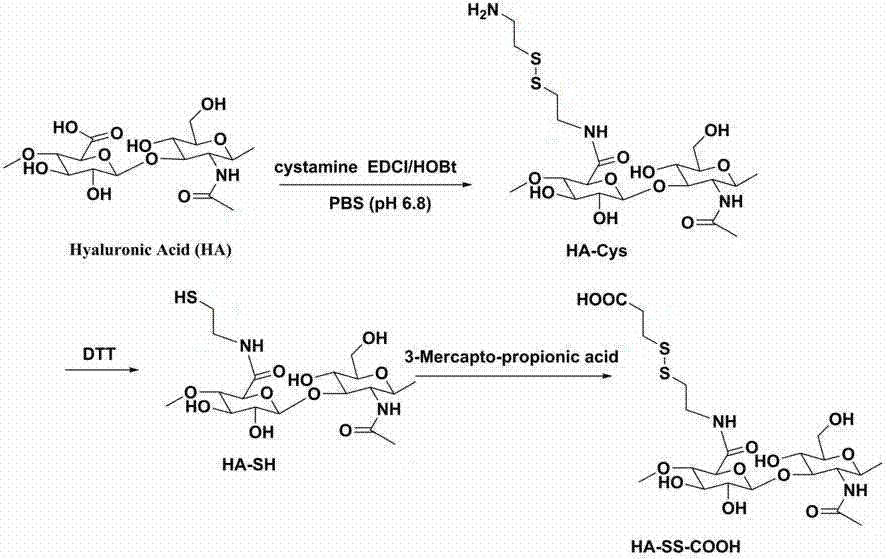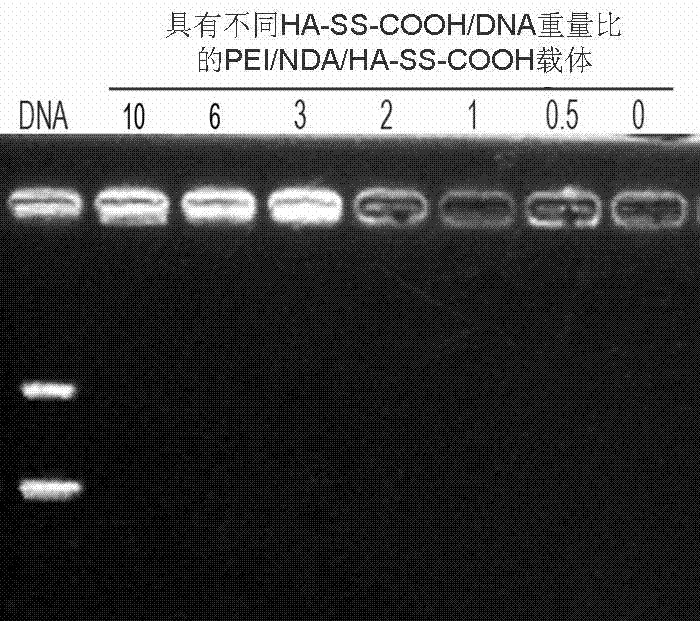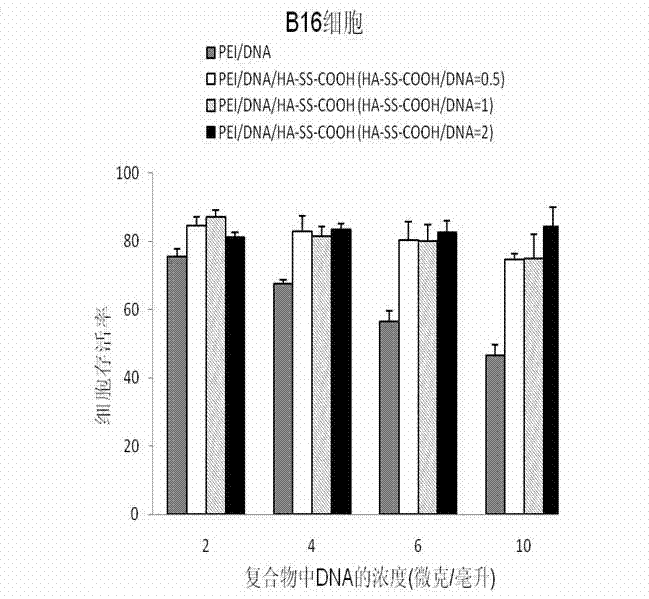Gene vector system, its preparation and application
A gene carrier and system technology, applied in the field of biomedical materials, can solve problems such as difficulty in functioning and reduce gene transfection efficiency, and achieve the effects of improving specific recognition and delivery, improving transfection efficiency, and increasing serum stability.
- Summary
- Abstract
- Description
- Claims
- Application Information
AI Technical Summary
Problems solved by technology
Method used
Image
Examples
Embodiment 1
[0030] Example 1: Preparation of reduction-sensitive masking system with targeting function
[0031] According to the feeding ratio described in Table 1, dissolve hyaluronic acid in phosphate buffer saline (PBS) with pH 6.8, add 1-(3-dimethylaminopropyl)-3-ethylcarbodiimide hydrochloride salt (EDC·HCl) and 1-hydroxybenzotriazole (HOBT), stirred, and reacted at room temperature for 2 hours to activate the carboxyl group. Add cystamine dihydrochloride (Cys), stir, and react the above reaction solution overnight at room temperature. After the reaction, the reaction product is dialyzed for 48 hours with a dialysis bag with a cut-off of 3500, and then freeze-dried to obtain cystamine-grafted transparent Hyaluronic acid (HA-Cys). The grafting ratio of cystamine in the product (HA-Cys) was calculated by nuclear magnetic spectrum, and the results are shown in Table 1.
[0032] Hyaluronic acid (HA-Cys) grafted with cystamine in different proportions was dissolved in phosphate buffe...
Embodiment 2
[0037] Example 2: Preparation of Gene Carrier System with Targeting Function Reduction Sensitive Masking System
[0038] Dissolve plasmid DNA in sterilized water to prepare DNA solution A with a concentration of 0.1 mg / mL; dissolve cationic polymer gene carrier polyethyleneimine (PEI) in sterile HBG buffer (4-hydroxyethylpiperazine ethanesulfonic acid 20 mmol, pH 7.4, 5% glucose), to prepare PEI solution B with a concentration of 0.01-1 mg / mL; dissolve the reduction-sensitive masking system (HA-SS-COOH) with targeting function In sterile HBG buffer, prepare HA-SS-COOH solution C with a concentration of 0.01-1 mg / mL.
[0039] The cationic polymer PEI solution of different concentrations and the plasmid DNA aqueous solution were mixed at a mass ratio of 1.2:1, and the mixed aqueous solution was incubated at room temperature for 20 minutes to obtain a PEI / DNA complex. Add different concentrations of HA-SS-COOH solutions, and incubate the aqueous solution at room temperature fo...
Embodiment 3
[0043] Example 3: Identification of the Stability of Complex Particles Using Gel Electrophoresis
[0044] Mix 5 μL of 0.1 mg / mL DNA solution with 3 μL of 0.2 mg / mL PEI solution, incubate at room temperature for 20 minutes, then add 5 μL of HA-SS-COOH solution of different concentrations to make HA-SS-COOH / DNA The mass ratios were 10, 6, 3, 2, 1 and 0.5, and after incubation at room temperature for 10 minutes, the gel electrophoresis retardation experiment was used to detect the complex particles after adding different amounts of HA-SS-COOH shielding system. stability.
[0045] figure 2 The results of electrophoresis show that the complex formed between the cationic polymer and DNA will not be destroyed when the amount of the HA-SS-COOH hyaluronic acid masking system added reaches 10 times the amount of DNA.
PUM
| Property | Measurement | Unit |
|---|---|---|
| molecular weight | aaaaa | aaaaa |
Abstract
Description
Claims
Application Information
 Login to View More
Login to View More - R&D
- Intellectual Property
- Life Sciences
- Materials
- Tech Scout
- Unparalleled Data Quality
- Higher Quality Content
- 60% Fewer Hallucinations
Browse by: Latest US Patents, China's latest patents, Technical Efficacy Thesaurus, Application Domain, Technology Topic, Popular Technical Reports.
© 2025 PatSnap. All rights reserved.Legal|Privacy policy|Modern Slavery Act Transparency Statement|Sitemap|About US| Contact US: help@patsnap.com



